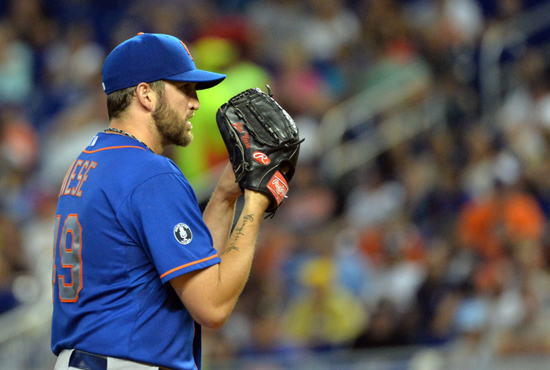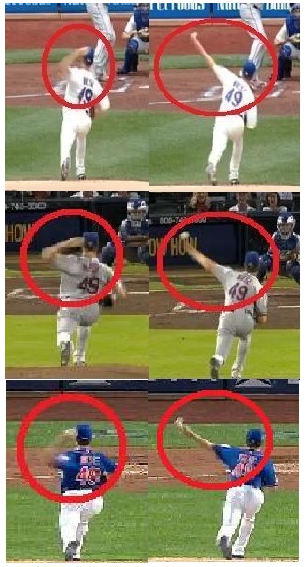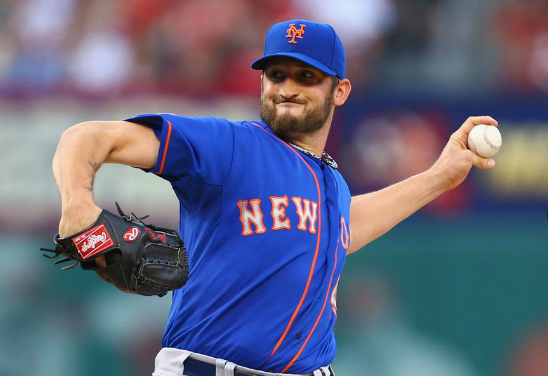
An MMO Fan Shot by Chris Malia (CJM)
Regarding fan opinion, Jon Niese is perhaps the most divisive player on the Mets. Scrolling through a comment thread about Niese, you can find opinions ranging from soft and overrated to gritty and extremely valuable. While value can be measured in terms of his stats and contract, his toughness or lack thereof is harder to determine. While heated arguments will produce opinions layered with stats and anecdotes, there is something yet to be explored regarding Jon Niese, happening beneath the surface of these stat and anecdote laden arguments. Jon Niese is evolving rapidly and substantially as a pitcher.
The secret is out—the Mets are concerned about Niese’s health. Nobody should be surprised. What is surprising—however—is that nobody’s really picked up on how significantly Jon Niese’s shoulder has actually affected his throwing. Not his performance, just his throwing. Take a look at the pictures.

All three of these pictures are screenshots of Niese throwing a fastball. The first picture is from 2010. Niese is delivering the ball almost directly over the top. The second picture is from 2012. You can see an obvious drop in arm slot as he’s gone to a more comfortable three-quarter release. The final picture is from 2014, and his arm slot has dropped even lower than in 2012. He seems to be getting closer and closer to a sidearm delivery.
Why is the arm slot dropping? His shoulder hurts. Obviously, anyone who’s played baseball or has been a fan of baseball understands that throwing over the top is unnatural. Three-quarter and sidearm deliveries put less stress on the arm, especially the shoulder. It’s not unusual to see pitchers’ arm slots drop as they age. Years and years of abuse will do that. When Pedro was with the Mets, his arm slot was significantly lower than it was during his glory years. In Niese’s case, we know with certainty that he’s dealt with shoulder issues. What we don’t know is whether the drop in arm slot has been implemented by Niese intentionally to try to preserve his shoulder’s health, or whether it’s been done because Niese simply can’t throw over the top without pain anymore. The reason behind the drop in arm slot—intentional or not—doesn’t have much bearing on the analysis to follow.
For Jon Niese, a drop in arm slot has forced him to change the way he pitches. When he came up, his most talked about weapon was the 12-6 curve. And it was a good pitch, unquestionably. However, the 12-6 curve relies on an over-the-top delivery. The over-the-top release allows the curve to have its sharp, off the table drop. Releasing the same pitch from the three-quarter slot will not produce as sharp a break. So if Niese is unable to produce the necessary over-the-top release, it stands to reason that he’d be less inclined to use his curveball and that his curveball would lose effectiveness. The numbers support that hypothesis. Here’s a look at his pitch selection from 2011 (his peak curve usage year) through 2014.
| Fastball | Curveball | Cutter | Changeup | |
| 2011 | 54.9 | 22.7 | 17.2 | 5.1 |
| 2012 | 49 | 19.4 | 27.8 | 3.8 |
| 2013 | 48.6 | 17.5 | 25.2 | 8.8 |
| 2014 | 49.6 | 16.9 | 24.2 | 9.2 |
The curveball column has been marked in bold. The data coincides with the drop in arm slot—Jon Niese has been using his curveball less and less over time, as usage has dropped nearly 6 percent since 2011. Jon Niese’s well documented shoulder issues seem likely to have caused this drop in arm slot, and subsequently a drop in curveball use.
Is it just pain that has caused Niese to use the curveball less? Earlier in the article, I mentioned 12-6 curveball effectiveness pertaining to arm slot. Not surprisingly, Niese’s effectiveness with the curve also appears to be waning. Here is a look at his groundball, line drive, and flyball rates using the curve from 2011 through 2014.
| Groundball % | Line Drive % | Flyball % | |
| 2011 | 66.7 | 19.2 | 14.1 |
| 2012 | 63.4 | 16.1 | 20.5 |
| 2013 | 56.3 | 18.4 | 25.3 |
| 2014 | 46.3 | 28.8 | 25 |
In 2011, two thirds of the curveballs put in play against Jon Niese were hit on the ground. Groundball rate has dropped 20% over 4 years. What was once a pitch Niese could pretty safely throw for a groundball is now a pitch that results in line drives and flyballs over half the time. I/t doesn’t take a Sandy Alderson computer manipulation to understand that grounders are preferable to line drives and flyballs.
What we’re left with is a pitcher who has lost his most effective weapon—perhaps his only true weapon as a pitcher. Niese has been forced to evolve. When looking at the pitch selection table, we see that fastball and cutter use have remained pretty consistent. But neither pitch is particularly fear-inducing. Niese was previously a pitcher who could rely on his curveball’s effectiveness to throw batters off-balance. Without that pitch, he has begun to turn to the changeup as an off-speed offering. His changeup usage has jumped from 3.8% in 2012 to 9.2% in 2014. The problem is, his changeup has failed to be as effective as his curveball once was. In 2013, his curveball produced grounders at a 55.9% rate and in 2014, that rate dropped to 47.4%–over half his changeups put in play in 2014 resulted in line drives or flyballs. Jon Niese is still searching for a way to throw batters off-balance without his curve.
Where does Niese go from here? A quick glance at Niese’s arm-slot drop and his curveball usage makes one think Niese is damaged goods. I’m not so sure that’s a fair assessment. Niese’s 2014 season was by no means bad. It was actually good. He threw 187 innings with a 3.40 ERA and a 3.67 FIP. Those are fine numbers for a mid-rotation starter, especially one getting paid what Niese is receiving. Somehow Niese managed to remain effective as a starter in 2014 with both his off-speed offerings producing the most ineffective results in his career. I don’t want to delve too much into Niese’s psyche, but it’s not a stretch to believe that this forced evolution in his pitching style has made pitching games more mentally rigorous than it once was.
Jon Niese is battling his way through the fire right now. To be successful, he needs to be a different pitcher than he was when he first came up. From that perspective, his 2014 season could be looked at as promising, because he was able to pitch effectively while adapting to new tools. Instead of lingering on what could’ve been with Niese and his curveball, lamenting the fact that he’s now damaged goods, I think I prefer to look at Niese as different goods. He’s not the same pitcher he was, but he has the potential to be as effective or more effective as he adjusts.
* * * * * * * *
This Fan Shot was contributed by MMO reader Chris Malia (CJM). Have something you want to say about the Mets? Share your opinions with over 25,000 Met fans who read this site daily. Send your Fan Shot to [email protected]. Or ask us about becoming a regular contributor.















